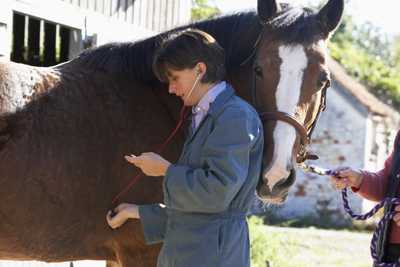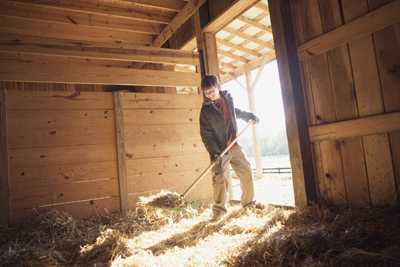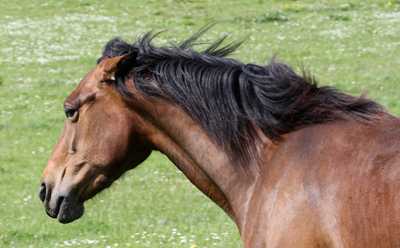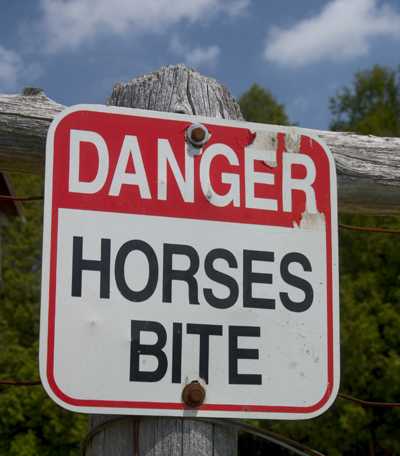Horses
See the Farm Animals page for information about other animals commonly found on farms.
CDC would like to thank Scott Weese, DVM, DVSc Diplomat of the American College of Veterinary Internal Medicine for his careful review of these pages.

Horse nuzzles girl's hand.

Storybook Farms
Visit Storybook Farms, a therapeutic riding center for mentally, physically, and emotionally handicapped children of all ages.
From pulling a plow over a farmer's field to carrying a cowboy across the open range, horses have always had an important role in society. Today, horses are generally considered companion animals, with close to 2 million U.S. households reporting horse ownership. Riding and working around horses have been shown to increase balance, self-confidence, and self-esteem. However, as with any animal, you must be aware of the risk for diseases passed between horses and people.
Although rare, germs from horses can cause a variety of illnesses in people, from minor skin infections to serious illnesses. Besides owning or touching a horse, common chores such as cleaning stalls and grooming might put you at risk. To protect yourself and your family from getting sick:
- Seek routine veterinary care for your horse and
- Always wash your hands and the hands of children with running water and soap after contact with horses or their manure.
Click the tabs above to learn more about preventing zoonotic diseases associated with horses.
Human illness from horses in the United States is rare, but it can happen.
The most common diseases associated with horses that can cause human illness are:
Salmonellosis (Salmonella spp.)
Salmonella are bacteria that spread to people through contaminated food (eggs and meat) or contact with the stool of certain animals, including horses. Horses infected with Salmonella might show no signs of the disease or could have watery diarrhea, depression, and severe dehydration.
People infected with Salmonella might have diarrhea, vomiting, fever, or abdominal cramps. Infants, elderly persons, and those with weakened immune systems are more likely than others to develop severe illness.
Ringworm (Trichophyton and Microsporum spp.)
Ringworm is a condition caused by a fungus that can infect the skin, hair, and nails of both humans and animals. Ringworm is spread from animals to humans through direct contact with an infected animal's skin or hair or through contact with contaminated equipment, such as brushes.
Ringworm in horses usually begins as a small raised bump that is hairless. The bump can become thick and scaly. Sometimes ringworm infection in horses causes circular, bald, scaly patches with broken hairs. Ringworm infection in horses is particularly common in cold climates where animals are stabled for long periods of time.
Ringworm infections in people can appear on almost any area of the body. These infections are usually itchy. Redness, scaling, cracking of the skin, or a ring-shaped rash may occur. If the infection involves the scalp or beard, hair may fall out. Infected nails become discolored or thick and may possibly crumble.
Less common diseases that are associated with horses and can cause human illness are:
Anthrax (Bacillus anthracis)
Anthrax is a naturally occurring disease of animals caused by the bacterium Bacillus anthracis. People and animals can get anthrax when they accidentally breathe in or swallow spores in contaminated soil, food, or water. Anthrax can also get into open wounds. People who live in areas where anthrax has occurred should consider vaccinating their livestock against the disease.
Anthrax is a serious but rare disease in the United States. The symptoms of anthrax depend on the type of infection and can take anywhere from 1 day to more than 2 months to appear. All types of anthrax have the potential, if untreated, to spread throughout the body and cause severe illness and even death.
Brucellosis (Brucella spp.)
Brucellosis is a bacterial disease that causes a condition called fistulous withers, or "poll evil," in horses and can affect the ability of animals to reproduce. The bacteria affect the bursa of ligaments at the withers or poll, causing inflammation and swelling. The inflamed tissue might eventually burst, resulting in drainage of pus and further infection of the surrounding tissue. Brucellosis rarely causes miscarriage in horses.
People can get the disease when they are in contact with infected animals or animal products contaminated with the bacteria. It is rare for people to get brucellosis from horses. One of the most common ways people become infected is through drinking unpasteurized (raw) milk. People who are infected with brucellosis will usually become sick within 6-8 weeks of exposure. Sick people will have flu-like symptoms that last 2-4 weeks. Sometimes brucellosis can become a chronic illness that can be difficult to treat.
Cryptosporidiosis (Cryptosporidium spp.)
Cryptosporidiosis is a parasitic disease that is spread to humans and animals through contaminated food or water or contact with an infected person or animal. The risk of Cryptosporidium from animals is hard to predict, because many animals carry the parasite without showing any signs of illness. Horses that do become sick might have abdominal pain and profuse watery diarrhea.
In people, Cryptosporidium causes profuse, watery diarrhea with cramping, abdominal pain, and nausea. Illness is usually self-limiting and typically resolves within 2–3 weeks. People with weakened immune systems might develop chronic or severe diarrhea.
Eastern Equine Encephalitis (EEE), Western Equine Encephalitis (WEE), St. Louis Encephalitis Virus (SLEV), and Venezuelan Encephalitis (VEE)
EEE, WEE, SLEV, and VEE are viruses carried by wild birds and transmitted by mosquitoes to horses and humans. Symptoms in horses can range from no signs of disease to depression, trouble walking or paralysis, convulsions, or other neurologic signs and death. Horses are dead-end hosts to EEE, WEE, and SLEV, which means that they usually do not spread these viruses to other animals or humans. Horses with a certain type of VEE infection, however, may be able to spread the virus through mosquitos.
People develop these diseases by being bitten by an infected mosquito. Most people have no symptoms, but for those who become sick, symptoms can range from mild flu-like symptoms to arthritis, respiratory distress, gastrointestinal upset, encephalitis, shock, or death. Very young or elderly patients are more likely to develop severe infections.
Human cases of SLEV have decreased from 13 cases in 2008 to 3 cases in 2012. Sporadic cases of EEE were reported in horses in 2012, but no cases of WEE were reported. VEE has not been seen in the United States since 1971.
Ehrlichiosis (Anaplasma phagocytophilum and Ehrlichia chaffeensis)
Ehrlichiosis is a bacterial disease that affects animals and humans, and is transmitted by ticks. Infected horses might have fever, swollen limbs, trouble walking, loss of stamina, and yellowing of the skin, mucous membranes, and whites of the eyes.
Humans infected with ehrlichiosis might have fever, headache, chills, muscle pain, nausea, vomiting, diarrhea, and rash. In 2011, 850 cases of ehrlichiosis were reported in humans.
Leptospirosis (Leptospira spp.)
Leptospirosis is a bacterial disease of humans and animals that is spread through contaminated water and urine or other body fluids from an infected animal. In horses, the disease is most often associated with uveitis (inflammation in the eye) and miscarriage. It has also been reported to cause kidney failure in foals. The prevalence of leptospirosis in horses is unknown, although it is responsible for 2%-4% of all equine miscarriages annually.
People who become infected with leptospirosis might not have any signs of the disease. Others will have nonspecific flu-like signs within 2-7 days after exposure. These symptoms usually resolve without medical treatment, but can reappear and lead to more severe disease.
Lyme Disease (Borrelia burgdorferi)
Lyme disease is a bacterial disease of humans and animals transmitted by ticks. In horses, the most common clinical sign is arthritis, but horses can also experience lameness, neurologic disease, eye disease, and dermatitis. Because Lyme disease can mimic so many other illnesses, it is very difficult to diagnose. This disease does not occur nationwide and is concentrated heavily in the Northeast and upper Midwest. In these areas, as many as 75% of adult horses are thought to have been exposed to the disease at least once in their lifetimes.
Infected people will typically have a red "bull's eye" rash at the site of the tick bite that appears about 7 days after being bitten. Flu-like symptoms quickly follow the rash. If not treated, this disease can spread to other parts of the body and cause symptoms such as arthritis and loss of facial muscle tone (Bell's palsy). Lyme disease can be fatal.
MRSA (Methicillin-Resistant Staphylococcus aureus)
Staphylococcus aureus is a common bacterium normally found on the skin of humans and animals. Methicillin-resistant Staphylococcus aureus (MRSA) is the same bacterium that has become resistant some antibiotics. Horses carrying MRSA might not necessarily show clinical signs, but MRSA can cause skin and wound infections, respiratory tract infections, and septic arthritis. Horses are more likely to carry MRSA if they live on a farm with more than 20 horses.
MRSA can be transmitted back and forth between people and animals through direct contact. In people, MRSA most often causes skin infections that can range from mild to severe. If left untreated, MRSA can spread to the bloodstream or lungs and cause life-threatening infections.
Rabies
Rabies is a virus that causes a fatal neurologic disease in animals and people. Bites from rabid animals or contact with infected saliva can spread the infection. Horses with rabies might have a variety of signs that rapidly worsen. Most frequently, rabid horses will have abrupt changes in their behavior (depression, agitation, aggressiveness) and might slowly develop paralysis. Rabid horses are often very dangerous and have attacked people. Though rabies is very rare in horses, it is still a concern. Horse owners should vaccinate their animals against this deadly disease.
It is rare for a person to contract rabies from a horse. The first symptoms in people can start days to months after exposure and include generalized weakness, fever, and headache. Within a few days symptoms will progress to confusion, anxiety, behavioral changes, and delirium. If you have been bitten by a dog or other animal and feel that there is a risk for rabies, contact your health care provider right away. Once symptoms appear, it is almost always too late for treatment.
West Nile Virus (WNV)
West Nile virus (WNV) is carried by birds and transmitted by mosquitos. People, birds, and horses get WNV by being bitten by an infected mosquito. Horses infected with WNV might not show any signs or might have muscle spasms and trouble walking, fever, or more severe neurologic deficits and death. Horses are not a source of WNV for mosquitoes; therefore, infected horses should not pose a risk to the people who take care of them.
In people, WNV might cause a wide range of symptoms from flu-like symptoms to seizures or more serious disease. WNV infection can be fatal in people. Most human infections have no symptoms, with approximately 20% of infected people developing West Nile fever and fewer than 1% developing a disease that affects the nervous system. Serious illness is more likely to occur in people over the age of 50. More than 2,500 cases of WNV disease are typically reported in the United States each year.
In this section
Healthy habits

Person washing their hands with soap and water.
CDC recommends hand washing whenever you work around or with horses.
- Wash your hands thoroughly with soap and running water after doing common chores with horses—especially after touching horse manure or urine, saliva, or blood.
- Wash your hands before eating, drinking, or smoking after handling horses.
- Cover any open wounds or cuts when visiting or working around horses.
- Seek routine veterinary care, vaccinations and deworming for your horse.
Tips for preventing horse-associated diseases and injuries
Before choosing a horse
- Learn about the different types of horses and temperaments before you bring one home. Find out what types of horses are suitable for your family. Certain types of horses, such as young or untrained horses, might not be suitable for young children or people with very little riding experience who are living in the household.
- Research how to properly care for your horse before purchase. Ask your veterinarian about the proper food, care, and stall or pasture environment for the horse you are selecting.
- Be aware of the potential for your horse to spread certain diseases to people at risk of being infected.
Choosing a horse

A veterinarian examines a horse.
- Match the horse's attitude, temperament, size, and training or activity level with your family and the purpose (e.g., showing, trail riding, teaching) for which you are buying the horse.
- Consider having the horse thoroughly examined by a veterinarian before purchase to make sure the animal is healthy and is not carrying infectious diseases that could pass to people. The veterinarian will evaluate the horse's eyes, heart, lungs, legs and hooves, digestive system, and skin.
- If you are bringing the horse into a herd setting, you might need to keep the horse separate for a short time to prevent any diseases from spreading to the other horses. Some general guidelines for choosing to separate a newly purchased horse are if they have:
- an unknown medical history or are coming from an unknown source, sale barn, or horse show where they have been in contact with unknown horses.
- traveled a long distance and are stressed or showing signs of disease, such as a cough, runny nose, swollen lymph nodes, fever or diarrhea.
For more information on separating newly acquired horses, contact your local veterinarian.
For more information on choosing a horse, read the American Veterinary Medical Association Selecting a Horse brochure.
Housing horses

Man cleaning a horse stall.
- Horses are usually housed either in a stall or out on pasture, or in a combination of both. If they are out on pasture, they should have some kind of shelter in case of inclement weather.
- Make sure your horse always has access to fresh clean water, whether in a stall or out on pasture.
- Keeping the stall cleaned regularly is important to prevent build-up of manure that could potentially spread disease to your horse or to other people.
Monitoring your horse's health
- Have your veterinarian come to the stables to routinely evaluate and care for your horse's health. Talk to your veterinarian about vaccinations for rabies, West Nile, and other viruses causing equine encephalitis.
- If possible, keep horses in an enclosed area at night to decrease their exposure to wild animals that could be carrying rabies.
- Use elevated feeders to reduce attracting wild animals.
- Clean horse enclosures and stalls daily to prevent build-up of manure.
- Properly dispose of soiled bedding, manure, and uneaten food.
Preventing bites and kicks

A horse with ears flattened.
- Avoid bites and kicks from horses.
- Be careful around horses. Always be aware of your surroundings and know where the animals are at all times.
- Approach a horse's head from the side—not the front—where they can see you better.
- Watch their ears—if flattened, the horse might bite.
- Don't stand directly behind a horse.
- Don't approach a horse from its rear end.
- Do not leave young children unsupervised around horses.
What to do if injured by a horse

Germs can spread from horse bites or kicks even if the wound does not seem deep or serious. If you are injured, you should:
- Wash wounds with warm soapy water immediately.
- Seek medical attention if:
- Vaccination status of the horse is unknown.
- The horse might have been exposed to a rabid wild animal. (Make sure a veterinarian checks your horse if it becomes sick or dies within 6 months of a bite from another animal.)
- The horse appears sick.
- The injury is serious (uncontrolled bleeding, loss of function, extreme pain, and muscle or bone exposure).
- The wound becomes red, painful, warm, or swollen.
- Your or your child's last tetanus shot was more than 5 years ago.
- You are concerned about your or your child's health.
Publications and Materials
Brochures
Selecting a Horse
American Veterinary Medical Association
Websites
Injury-related information
Activity Card: Horseback Riding
BAM! Body and Mind, CDC
Nonfatal Animal-Related Farm Injuries to Youth in the United States [PDF – 27 pages]
CDC
Safety and Health in the Horse Racing Industry
CDC
Heads Up: Preventing Concussion fact sheet [PDF – 2 pages]
CDC
Horse Stabled at Tennessee Walking Horse 2006 National Celebration Tested Positive for Rabies
CDC
Vesicular Stomatitis [PDF – 2 pages]
U.S. Department of Agriculture Animal and Plant Health Inspection Service. (2007).
Podcasts
Heads Up! Play it Safe When It Comes to Concussions podcast
CDC
Helpful books and references
Blunden, A. S., Smith, K. C., Neal, H. N., & Dugdale, D. J. (2006). Enteritis associated with infection by Campylobacter jejuni in two Thoroughbred foals. Equine Vet. Educ. 18(1), 8-10.
Compendium of Measures to Prevent Disease Associated with Animals in a Public Setting [PDF – 19 pages]
J Am Vet Med Assoc 2013:243(9) 1270-1288
West Nile Virus and Other Arboviral Diseases – United States, 2010.
Morbidity and Mortality Weekly Report (MMWR). August 5, 2011 / 60(30);1009-1013
Langley, R. & Morris, T. (2009). That Horse Bit Me: Zoonotic Infections of Equines to Consider after Exposure Through the Bite or the Oral/Nasal Secretions. Journal of Agromedicine 14, 370–381
Weese, J. S. (2002). A Review of Equine Zoonotic Diseases: Risks in Veterinary Medicine. American Association of Equine Practitioners Proceedings 48, 362-369.
- Page last reviewed: June 2, 2014
- Page last updated: June 2, 2014
- Content source:


 ShareCompartir
ShareCompartir